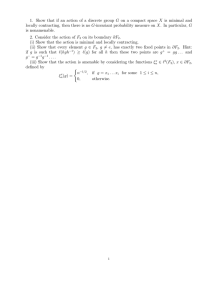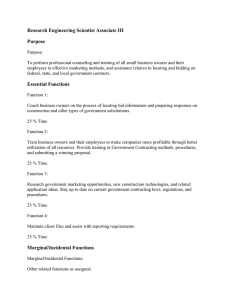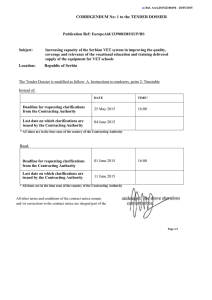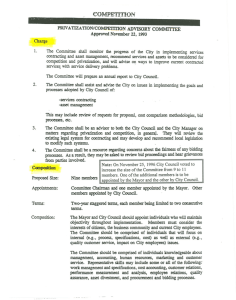Annex-III of SAPTA SAPTA RULES OF ORIGIN RULES OF ORIGIN
advertisement
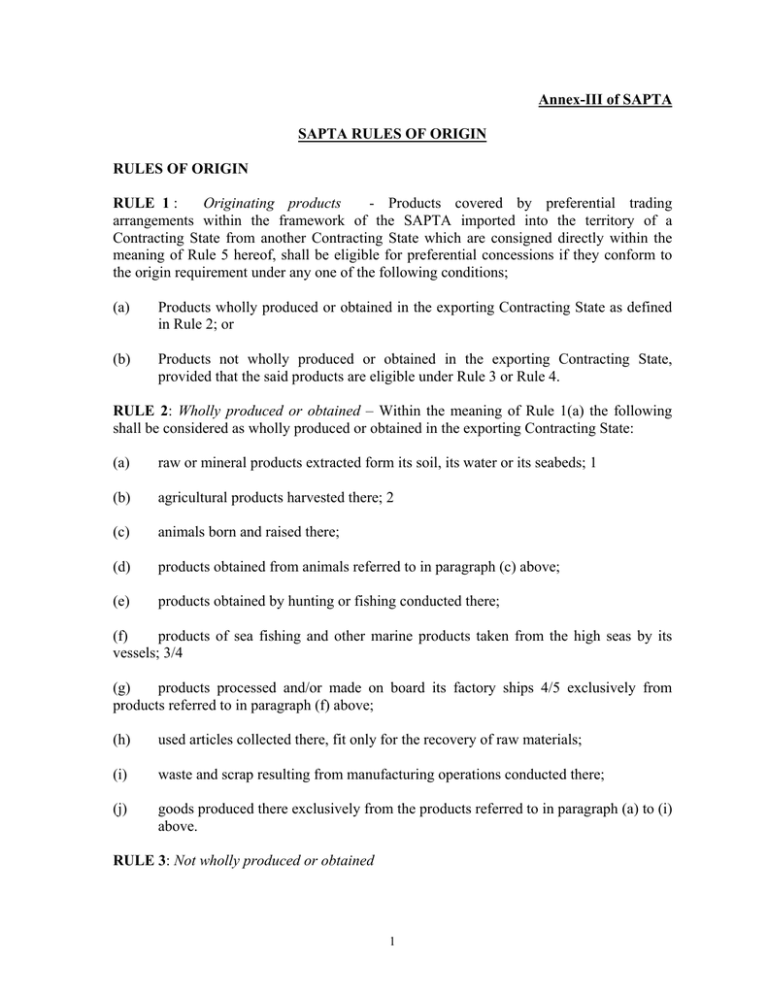
Annex-III of SAPTA SAPTA RULES OF ORIGIN RULES OF ORIGIN RULE 1 : Originating products - Products covered by preferential trading arrangements within the framework of the SAPTA imported into the territory of a Contracting State from another Contracting State which are consigned directly within the meaning of Rule 5 hereof, shall be eligible for preferential concessions if they conform to the origin requirement under any one of the following conditions; (a) Products wholly produced or obtained in the exporting Contracting State as defined in Rule 2; or (b) Products not wholly produced or obtained in the exporting Contracting State, provided that the said products are eligible under Rule 3 or Rule 4. RULE 2: Wholly produced or obtained – Within the meaning of Rule 1(a) the following shall be considered as wholly produced or obtained in the exporting Contracting State: (a) raw or mineral products extracted form its soil, its water or its seabeds; 1 (b) agricultural products harvested there; 2 (c) animals born and raised there; (d) products obtained from animals referred to in paragraph (c) above; (e) products obtained by hunting or fishing conducted there; (f) products of sea fishing and other marine products taken from the high seas by its vessels; 3/4 (g) products processed and/or made on board its factory ships 4/5 exclusively from products referred to in paragraph (f) above; (h) used articles collected there, fit only for the recovery of raw materials; (i) waste and scrap resulting from manufacturing operations conducted there; (j) goods produced there exclusively from the products referred to in paragraph (a) to (i) above. RULE 3: Not wholly produced or obtained 1 (a) Within the meaning of Rule 1(b), products worked on or processed as a result of which the total value of the materials, parts or produce originating from nonContracting States or of undermined origin used does not exceed 60* per cent of the f.o.b value of the products produced or obtained and the final process of manufacture is performed within the territory of the exporting Contracting State shall be eligible for preferential concessions subject to the provisions of Rule 3(c) and Rule 4. (b) Sectoral agreements 6 (c) The value of the non-originating materials, parts or produce shall be : (i) The c.i.f. value at the time of importation of materials parts or produce where this can be proven: or (ii) The earliest ascertainable price paid for the materials, prices or produce of undermentioned origin in the territory of the Contracting State where the working or processing takes place. RULE 4: Cumulative rules of origin – Products which comply with origin requirements provided for in Rule 1 and which are used by a Contracting State as input for a finished product eligible for a preferential treatment by another Contracting State shall be considered as a product originating in the territory of the Contracting State where working or processing of the finished product has taken place provided that the aggregate content originating in the territory of the Contracting State is not less than 50* percent of its f.o.b. value 7. RULE 5 : Direct consignment – The following shall be considered as directly consigned from the exporting Contracting State to the importing Contracting State : (a) (b) if the products are transported without passing through the territory of any nonContracting State : the products whose transport involves transit through one or more intermediate nonContracting State with or without transshipment or temporary storage in such countries, provided that : (i) the transit entry is justified for geographical reason or by considerations related exclusively to transport requirements; (ii) the products have not entered into trade or consumption there; and (iii) the products have not undergone any operation there other than unloading and reloading or any operation required to keep them in good condition. 2 RULE 6 : Treatment of packing – When determining the origin of products, packing should be considered as forming a whole with the product it contains. However, packing may be treated separately if the national legislation so required. RULE 7: Certificate of Origin – Products eligible for preferential concessions shall be supported by Certificate of Origin issued by an authority designated by the government of the exporting Contracting State and notified to the other Contracting State in accordance with the Certification Procedures appearing on page --, -- and -- of this Annex. RULE 8: (a) In conformity with Article 15 of the Agreement on SAPTA and national legislations, any Contracting State may prohibit importation of products containing any inputs originating from States with which it does not have economic and commercial relations. (b) Contracting State will do their best to co-operate in order to specify origin of inputs in the Certificate of Origin. RULE 9: Review – These Rules may be reviewed as and when necessary upon request of one-third of the Contracting State and may be open to such modifications as may be agreed upon. RULE 10: Special criteria percentage – Products originating in Least Developed Contracting States can be allowed a favourable 10 percentage points applied to the percentage established in Rules 3 and 4. Thus, for Rule 3, the percentage would not exceed 70* per cent, an ∗ d for Rule, the percentage would not be less than 40* per cent. 1. ores. Include mineral fuels, lubricants and related materials as well as mineral of metal 2. Include forestry products. 3. “Vessels” – shall refer to fishing vessels engages in commercial fishing, registered in Contracting State’s country and operated by a citizen or citizens or governments of Contracting State or partnership, corporation or association, duly registered in such Contracting State’s country, at cost 60 per cent of equity of which is owned by a citizen or citizens and/or government of such Contracting State or 75 percent by citizens and/or governments of the Contracting States. However, the products taken from vessels engaged in commercial fishing under bilateral agreements which provide for chartering/leasing of such vessels and/or sharing of catch between Contracting States will also be eligible for preferential concessions. 4. In respect of vessels of factory ships operated by government agencies the requirement of flying the flag of a Contracting State does not apply. ∗ 10% lower down in the value addition was made vide customs notification no. dated … in view if the decision 3 5. For the purpose of this Agreement, the term “factory ship” means any vessels, as defined, used for processing and/or making on board products exclusively from those products referred to in paragraph (f) above. 6. In respect of products traded within the framework of sectoral agreements negotiated under SAPTA, provision may need to be made for special criteria to apply. Consideration may be given to these criteria as and when the sectoral agreements are negotiated. 7. “Partial” cumulation as implied by Rule 4 above means that only products which have acquired originating status in the territory of one Contracting State may be taken into account when used as inputs for a finished product eligible for preferential treatment in the territory of another Contracting State. 8. A standard Certificate of Origin to be used by all Contracting States is annexed and approved by the Contracting States. 4 CHAPTER III CERTIFIATE OF ORIGIN 1. Goods consigned from (exporters’ business name, address, country) Reference No. Goods consigned to (consignee’s SAARC PREFERNTIAL TRAIDNG name, address, country) ARRANGEMENT (SAPTA) (Combined declaration and certification Issued in……………………. (Country) see notes overleaf 3. Means of transport and route (as far 4. For Official use as known) 5. Tariff 6. Marks and 7. Number 8. Origin 9. Gross 9. Number item numbers and kind criterion weight and date (see notes or of number of of packages overleaf) other invoices packages descripti quantity on of goods 10. Declaration by the exporter: 12. Certificate The undersigned hereby declares that It is hereby certified on the basis of the above details and statements are control carried out, that the correct: declaration by the exporter is correct. that all the goods were produced in 2. …………………………………… (Country) and that they comply with the origin requirements specified for those goods in SAPTA for goods exported to …………………………………… (importing Country) ………………………………….. …………………………………… Place and date, signature of authorised Place and date, signature of authorised signatory signatory 5 I. General Conditions To qualify for preference, products must: (a) fall within a description of products eligible for preference in the schedule of concession of SAPTA country of destination; (b) comply with SAPTA Rules of Origin. Each article in a consignment must qualify separately in its own right; and (c) comply with the consignment conditions specified by the SAPTA Rules of Origin. In general, products must be consigned directly within the meaning of Rule 5 hereof from the country of exportation to the country of destination. II. Entries to be made in Box 8 Preference products must be wholly produced or obtained in the exporting Contracting State in accordance with Rule 2 of the SAPTA Rules of Origin, or where not wholly produced or obtained in the exporting Contracting States must be eligible under Rule 3 or Rule 4. (a) Products wholly produced or obtained; enter the letter “A” in Box 8. (b) Products not wholly produced or obtained : the entry in Box 8 should be as follows: 1 Enter letter “B” in Box 8, for products which meet the origin criteria according to Rule 3. Entry of letter would be followed by the sum of the value of materials, parts or produce originating from non-Contracting States, or undetermined origin used, expressed as a percentage of the f.o.b. value of the products; (example “B” 50 per cent); 2 Enter letter “C” in Box 8 for products which meet the origin criteria according to Rule 4. Entry of letter “C” would be followed by the sum of the aggregate content originating in the territory of the exporting Contracting State expressed as a percentage of the f.o.b. value of the exported product; a. (example “C” 60 per cent); 3 Enter letter “D” in Box 8 for products which meet the special origin criteria according to Rule 10. 6
